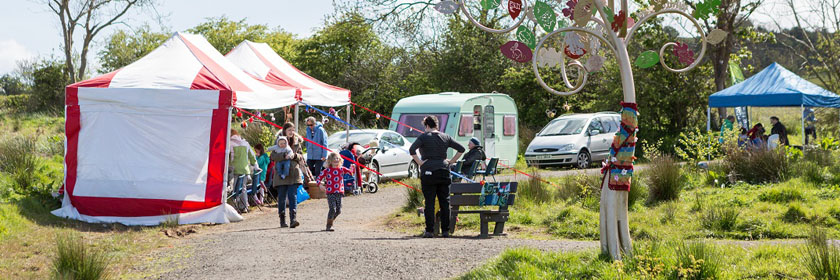Diamond Jubilee Wood

This 60 acre native woodland site was developed by the Council and the Woodland Trust in a partnership projected to commemorate the 2012 Diamond Jubilee, marking Queen Elizabeth’s 60th year as a monarch.
Whitehead Diamond Jubilee Wood is one of 60 Diamond Jubilee Woods throughout the UK and the only on in Northern Ireland.
The site is a haven for wildlife largely due to the variety of habitats.
In addition to woodland a walk around the 2km circular route will enable you to experience a wildlife pond, wildflower areas, native hedgerows as well as picnic/BBQ areas, gym equipment and range of sculptures.
Friends of Whitehead Diamond Jubilee Wood
The woodland includes an orchard planted and maintained by the Friends of Whitehead Diamond Jubilee Wood.
This is a group of local volunteers who dedicate their time and energy to care for and improve this beautiful site
To find out more about this or other Friends of Groups in the area get in touch!
Visit our 'Friends Of' Volunteer Groups page.
Opening Hours, Facilities and Location
Diamond Jubilee Wood is open 24 hours a day.
There are picnic and barbequing facilities in Diamond Jubilee Wood, as well as outdoor gym facilities which are all free to use.
Location:
A site map of the Wood is available for download.
History
From 1915 to 1917, the site was home to the first military aviation facility in Ireland - one that played an important role in the First World War.
Royal Naval Air Service airships based at Bentra patrolled the waters between Ireland and Scotland, combating the German U-Boat menace.
The airships operated from an airship station at Bentra, which had an airship shed comprising a steel frame covered by canvas and measuring 150 feet long by 45 feet wide and 50 feet high.
Wooden huts provided accommodation for the pilots and engineers.
At least four airships operated from the station at Bentra - SSZ11, SSZ12, SS20 and SS23.
Various types of aircraft also landed at the station and it became known as Whitehead Aerodrome.
Affectionately named "battlebags" by their crews and "blimps" by civilians, Royal Naval Air Service airships were a familiar sight around Britain's shores during the war years 1914 - 1918.
At least 226 airships were built and operated by the Royal Navy during the First World War in a bid to beat the deadly German U-boats.
Action in the Air
The primary task for the airships stationed at the Bentra Aerodrome was to protect the Princess Maud cross channel ferry and guard incoming convoys in the North Channel from German submarines.
When the prevailing wind permitted, the crew would scout from the air, looking for submarines on the surface or the wake of a periscope.
Success depended on close cooperation between the naval airmen and the warships operating from Larne harbour.